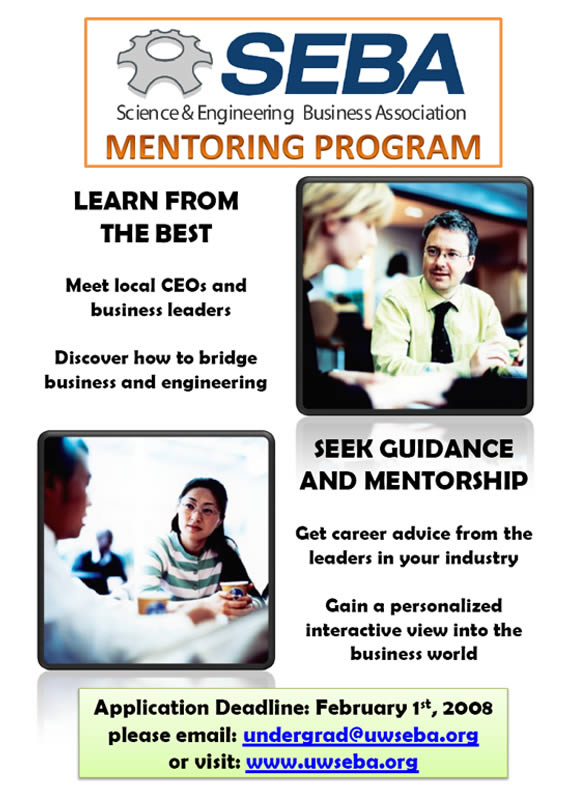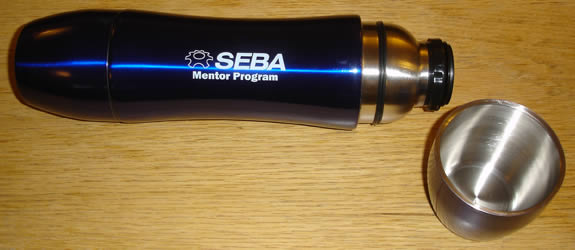
Menu:
Mentoring Program
I joined the University of Washington Science and Engineering Business Association (SEBA) during the summer after my junior year as the only undergraduate officer. After joining I was put in charge of setting up a mentoring program for SEBA members. The program was intended to give engineering students who are interested in business some networking skills along with advice and direction from the mentors.
The program started with a conversation between myself, Rob Burke (the president of SEBA at the time), and Anthony Rodriguez (the VP of membership at the time). We discussed what each of us would want out of the program and some ideas for how to go about starting it.
After this initial meeting, I started setting up an outline for the program, as well as documents to send to both students and potential mentors to get them interested in the program.
In December of 2007 I met with Rob Burke and Susan Canfield (the director for the UW MBA Mentor Program) to create a more finalized version of my plan before launching the program.
In order to make sure the students who signed up for the program were serious about it, I decided to require that they fill out an application before they would be accepted. A deadline was set for the applications and a flyer was created to post around the UW campus. An image of the flyer, designed by Geoffrey Berguig, is shown below.

In addition to the flyer, emails were sent to SEBA members with the application information. In total 38 applications were received. Of the 38 who applied, 32 fit the scope of the program and were asked to fill out a survey that would help guide the mentor search. Questions such as "What industry do you want your mentor to be involved with?" and "Do you have a specific company or person you would be interested in?" were asked.
After collecting this data, I set up a meeting with Connie Bourassa-Shaw (director of the UW Center for Innovation and Entrepreneurship) and Janis Machala (founder of Paladin Partners) for assistance in finding mentors who fit the interests of our applicants.
Through emails, phone conversations, and one-on-one meetings I was able to find nine mentors who were interested in participating:
- Steve Arnold, Venture Partner, co-founder - Polaris Ventures
- Jason Barnwell, Associate - Heller Ehrman
- Brett Gaspers, Managing Director - Objective Insights
- Douglas Hansmann, Chief Operating Officer - EKOS Corporation
- Eric Koester, Associate - Heller Ehrman
- Margaret McCormick, Partner - Integra Ventures
- Jeffrey Miller, Board of Directors - Koronis Pharmaceuticals
- Christopher Porter, President - Medical Genesis
- Carl Weissman, Chief Executive Officer - Accelerator Corporation
Once the mentors had agreed to participate, a list with their profiles was sent to the students who were asked to rank their top three choices. Each student was assigned to a mentor, and then a time was scheduled for the mentor and students (usually three to five students per mentor) to meet.
Before the students met with the mentors, they were required to attend a business etiquette meeting led by Janis Machala. This meeting was designed to prepare the students to meet with their mentors so they would get the most out of the experience.
Students met with the mentors for one to two hours either on campus or at the mentor's place of business. Most mentors would explain their background, talk about their careers, and then let the students ask questions. At the end of each meeting I gave the mentor a thermos with the SEBA logo as a thank you for their time. An image of the thermos is shown below.

At the end of the program I assembled a folder with all of the documents I had created during the year. I also put together a document explaining everything in the folder and giving advice for ways to make the overall process more streamlined. This was put together to assist students who would be running the program in the following years.
The 2010-2011 school year will be the third year for the SEBA Mentoring Program.
Page created: 2010